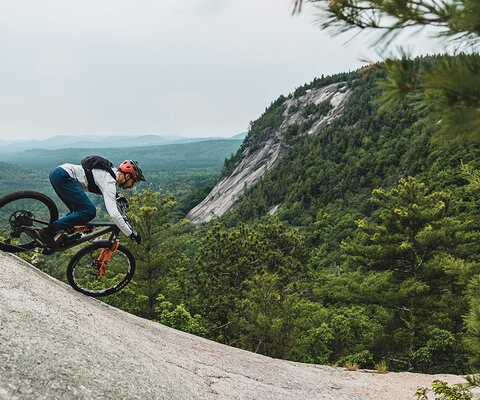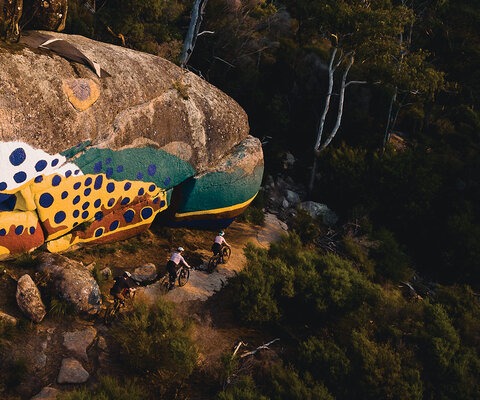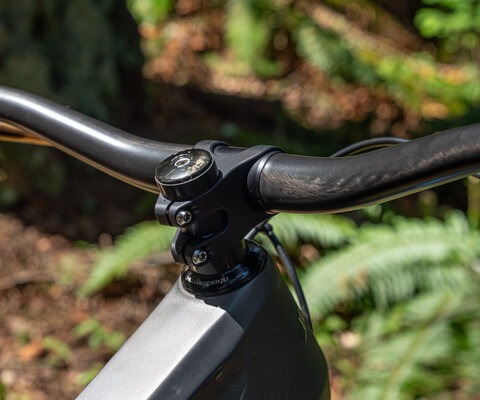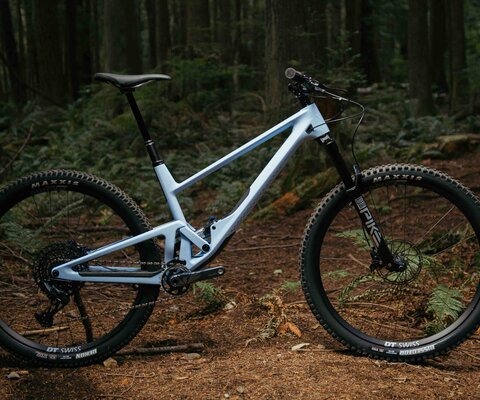
One Piece at a Time Cuba's Mountain Bike Revolution
Words and Photos by Paris Gore
Fifteen Cubans and one American shuffle about on a hillside above town, mounted on 15 pieced-together mountain bikes and one cutting edge trail rig.
The city of Holguín sprawls far below, a network of streets and parks hemmed in by forested mountains. While not visible from our perch, to the north is the Caribbean Sea and a coastline of white sand beaches—the same beaches on which Christopher Columbus first landed in 1492, declaring the island the “most beautiful country human eyes had ever seen.”
We, however, are not in Cuba for the beaches. We’re here for the posse of locals surrounding us. More accurately, the burgeoning and unlikely scene they represent—that, and the tallest peak in Cuba, Pico Turquino, located some 150 miles to the southwest.
The American on the trail rig is pro freerider Aaron Chase, and this trip began with a phone call from Chase a month before. In early January, he called me up with an idea: Travel to Cuba, ride Pico Turquino, and explore the surrounding area. Thanks to a U.S. imposed trade embargo, the communist country has been largely isolated since the 1960s, creating a sort of time capsule—and, we hoped, preserving some of the trails used by rebel leader Fidel Castro when he was hiding in the forests around Pico Turquino.
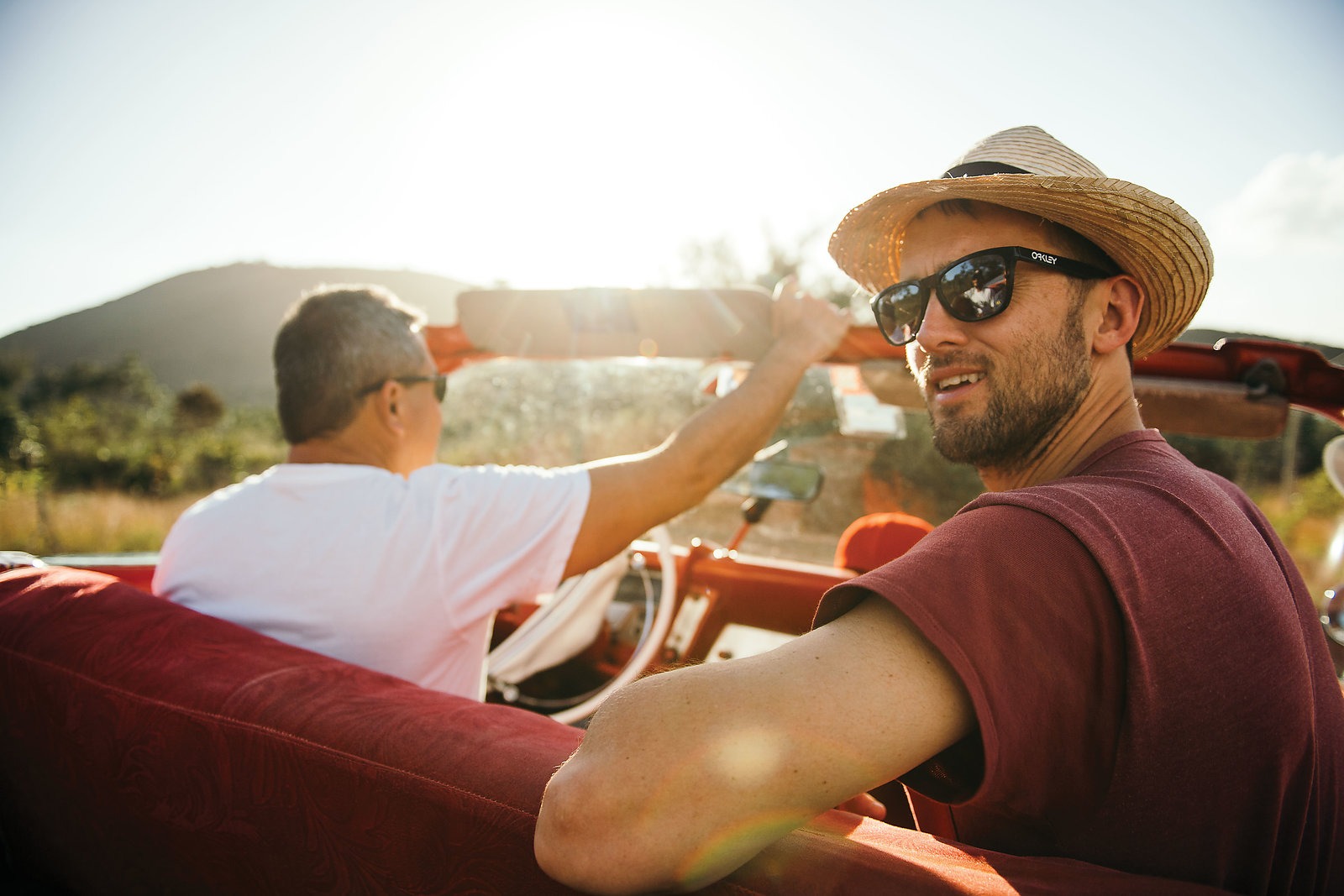
We are not the first outsiders with such intentions; adventure legend Hans Rey and Tarek Rasouli rode Pico Turquino way back in 2002. But Chase had a connection: His friend “KB” owns KB Tambo Travel company and has been running tours in Cuba for years. He offered to put us in touch with his go-to guide, Oscar Carballido, who lives in Holguín and knows all the trails in the area.
Which brings us to this hillside in early February, joking with Oscar and his friends before dropping in. It’s the last day of the trip, and we’ve already ridden 30 miles since this morning—an impressive feat, considering the locals’ rigs include everything from downhill bikes to entry-level hardtails. Our Pico Turquino mission is days behind us, but this is the community we’ve come searching for, so passionate that no embargo or shortage of parts can stop them from riding—pure mountain bike soul in a country stuck in time.
A car is somewhat of a novelty in Cuba; most citizens don’t own one. The country is a mix of the rural 1900s and inner- city 1960s, glued together with a bit of modernity, and it’s more common to see a family in a horse-drawn buggy than a new automobile. Which is why, when I arrived to meet Oscar in the capital city of Havana, the cars I saw were so noticeable: shiny Chevys and Fords that could have come straight from a 1950s auto lot.
As I walked through the city’s grand historic buildings, I could almost envision Ernest Hemingway 70 years before, sipping a daiquiri and watching the now-vintage automobiles roll past.
The colorful station wagons and convertibles are also one of the most noticeable representations of Cuba’s history. As I walked through the city’s grand historic buildings, I could almost envision Ernest Hemingway 70 years before, sipping a daiquiri and watching the now-vintage automobiles roll past. But these days many of the buildings are past their prime, and the busted-up pavement isn’t kind to the old vehicles’ suspension.
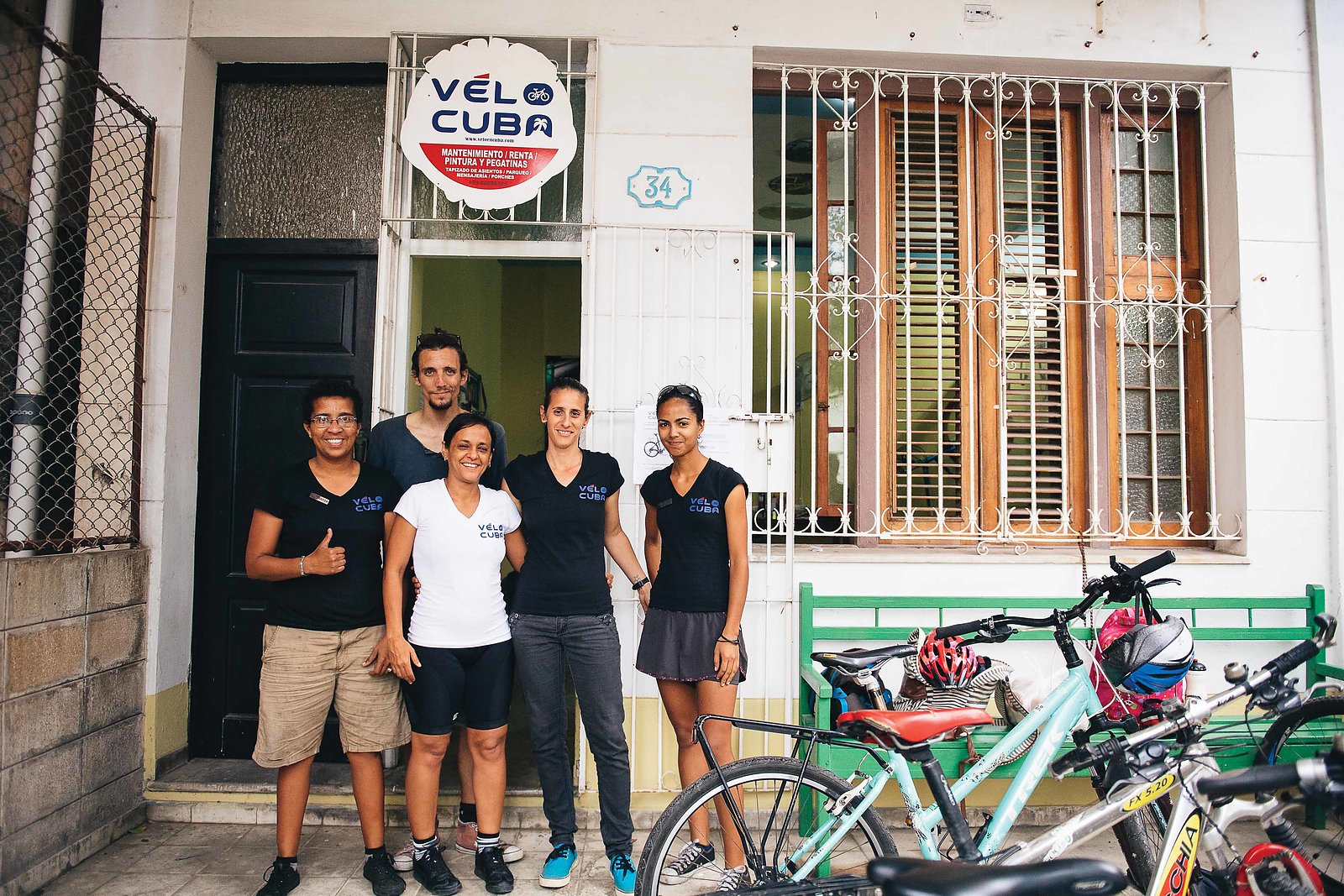
It’s a contrast that is as much cultural as it is physical, one that officially began in 1953 when rebel leader Fidel Castro led a revolt against the U.S.-backed Cuban President Fulgencio Batista. After a half-decade of fighting, Castro’s forces overthrew Batista in 1959 and established the communist Republic of Cuba with Castro as prime minister. Relations with the United States soon turned ugly; the United States began imposing a series of embargoes in 1960 that escalated into a near-total trade ban in 1962. The ban has remained ever since, cutting imports to Cuba from the modernized outside world to a trickle. This includes from European countries, who condemn Cuba’s poor human rights record and fear fines from the United States.
There are some modern vehicles, including Peugeots and Kias, but most are Russian and most are owned by the government. Yet even with such limited transportation options, there are surprisingly few bikes in Cuba. A few roam the streets, and bike taxis are one of the more efficient ways to get around, but most are somewhere between old, rigid Schwinns and newer, price-point commuters. Anything remotely high-end or high-tech simply does not exist—which made my modern, full-suspension trail rig look like something from space.
The next day, Oscar and I headed to the airport to pick up Chase, who was flying in from New Hampshire. Despite what most people believe, it is possible for Americans to visit Cuba—there’s just some heavy fine print. While the 1962 embargo makes it illegal for Americans to travel to Cuba as individual tourists, booking as a group through a travel organization is allowed. Or you can meet one of 12 exception categories, including participating in public athletic performances such as our “race” in Holguín, which allowed us to qualify for a sports visa.
Though the infrastructure has decayed since Hemingway’s time, Cuba’s urban culture is still colorful and festive, and we spent the day cruising around Havana, enjoying the food, music and general bustle of the city’s two-million-plus citizens. Another American travel caveat is that it’s illegal to have financial transactions with military-associated businesses, which is a wide-ranging list in the communist country. In some ways that’s a good thing: Most individually owned restaurants and Airbnb-style homestays don’t have ties to the government, which encourages visitors to interact with locals.
One such business is Nayvis Dìaz’s bike shop, which we visited via a 1952 Chevy convertible taxi. Beyond employing professional mechanics, an uncommon trade until recently, Dìaz—a mechanic herself—is empowering local women by teaching them to work on their own bikes, both as customers and shop techs. She started the shop with an emphasis on rentals and guided tours, but these days her focus is mostly service-oriented, difficult work considering her replacement components are limited to a small bin of rusty parts. But she has a big vision. Dìaz hopes to start a bike-share program in Havana similar to those in Amsterdam and New York City, providing anyone in the city with pedal power. It’s a dream that will have to wait, however, as importing bikes is tough. Until then she’s dedicated to repairing what few rentals they do have, bringing women into the sport one broken drivetrain at a time.
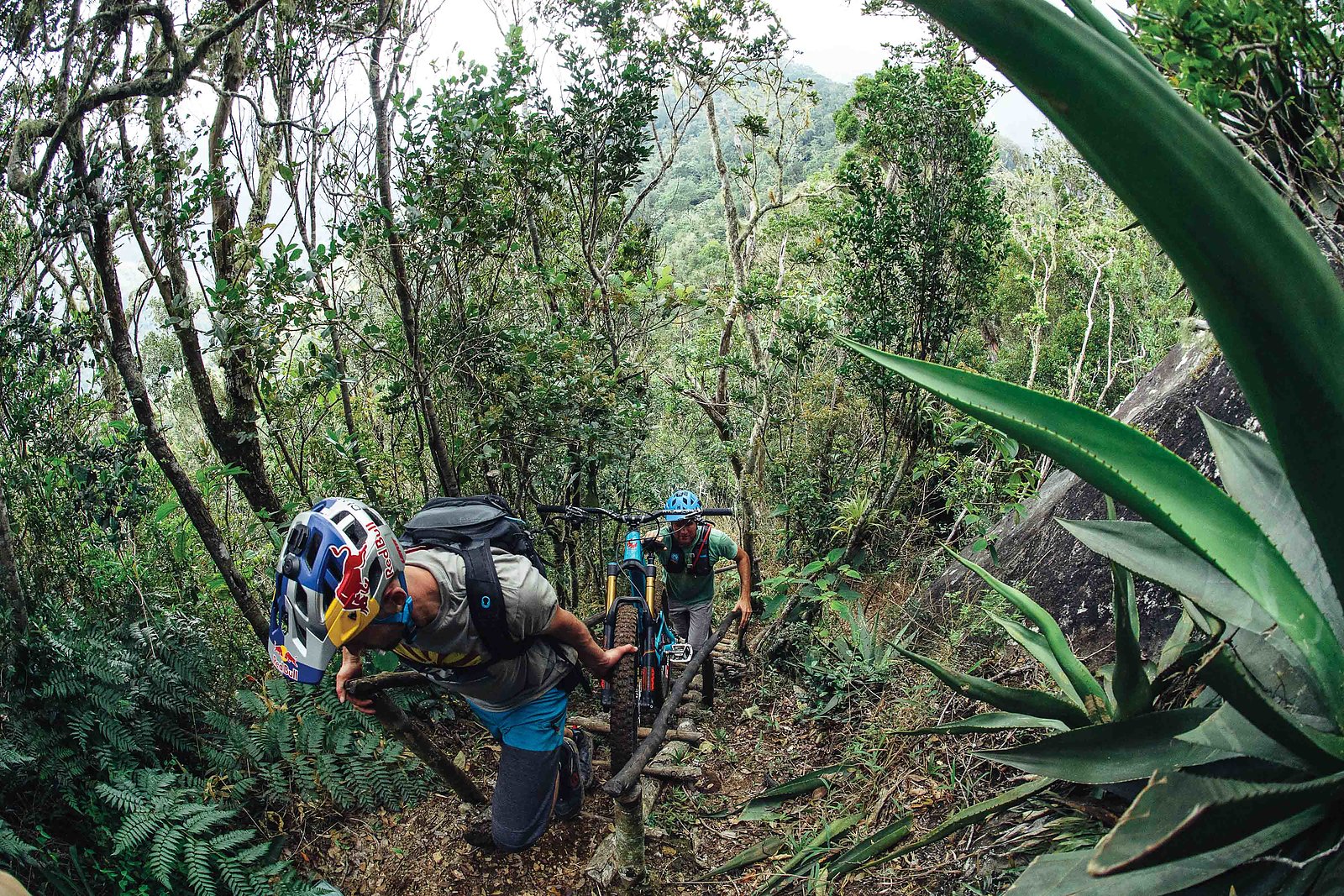
Having gotten our cultural fix, we left the swirl and bustle of Havana the next day and headed south toward the Holquín airport, where we met Chase’s childhood friend, Tom Dunfee. Besides being a stellar rider and human, Dunfee is also a paramedic in Fort Lauderdale, FL, a real benefit considering the dangers presented by climbing Cuba’s tallest mountain. Located in the heart of Turquino National Park, the peak is remote and, in the case of a severe injury, rescue helicopters aren’t an option. While Cuba’s medical system is decent, trauma care is unreliable at best.
Five bikes fit perfectly on our rental vehicle, an early 1950s Ford Willys jeep with bare-metal bench seats and a disregard for emission standards. While utilitarian, it made easy work of our early morning drive into the mountains, leaving a steady wisp of black exhaust in its wake all the way to the final 40-degree punch into the trailhead parking lot.
We reached the first piece of history only a few miles down the trail: Fidel Castro’s early hideout, where he planned much of his 1953 revolution. He chose the area for its rugged terrain, and we knew there were trails through the jungle. Beyond that, it was anyone’s guess as to what riding those trails would be like.
Our plan was to hike five miles that day, spend the night at a backcountry lodge, finish the final 2.5 miles to the summit the next morning, and then ride down the other side of the mountain to the ocean. Easy enough, it seemed, except those first five miles were spread along a 4,200-vertical-foot climb up a relentless series of steep, wooden staircases. Our appreciation for the three local porters we’d hired grew with each step, as did our apprehension. If the trail up was this brutal, what would the trail down look like?
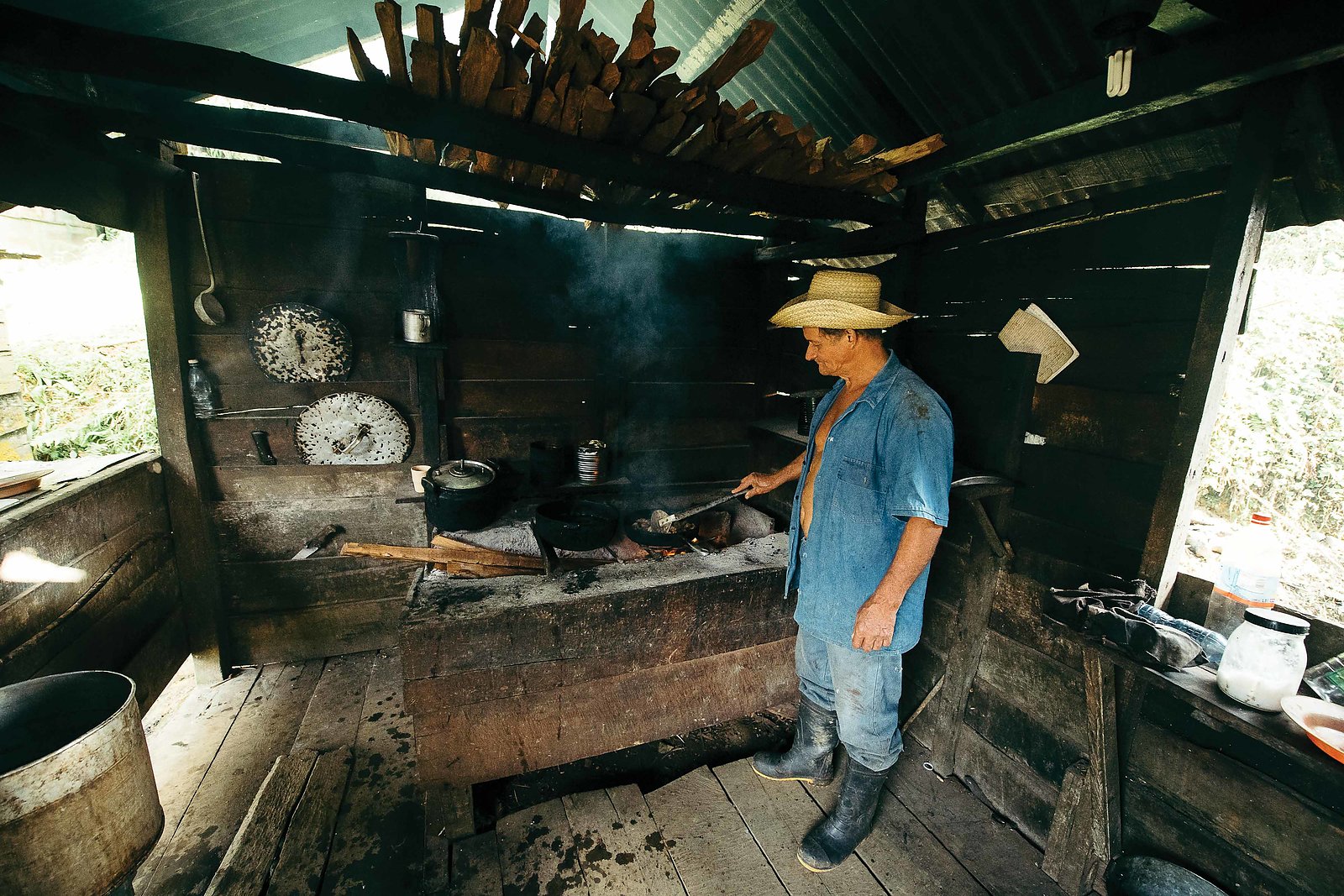
We eventually reached the “lodge,” two small shacks in a clearing on the hillside. The caretaker, a man with two teeth and a huge scar down his chest from getting hit by a car, greeted us with a warm welcome and a big bottle of rum. After dinner, two of the porters began running through jiu-jitsu stances, as if they hadn’t climbed straight up for eight hours, while we settled into our bunks to finish off the rum. The combination of alcohol and fatigue was crucial, overpowering our fear of the large spiders we discovered roaming the perimeters of the room.
The brutal grade continued the next morning, but after a multi-hour, 2,300-vertical-foot grind we finally reached the summit. At nearly 6,500 feet above the Caribbean, it was a view reserved for planes and birds—that is, when it wasn’t obscured by the type of heavy fog that coated us in dew and cut visibility to a few hundred feet. Besides a statue of Cuban national hero José Martí, our world was limited to 360 degrees of clouds and vibrant green forest.
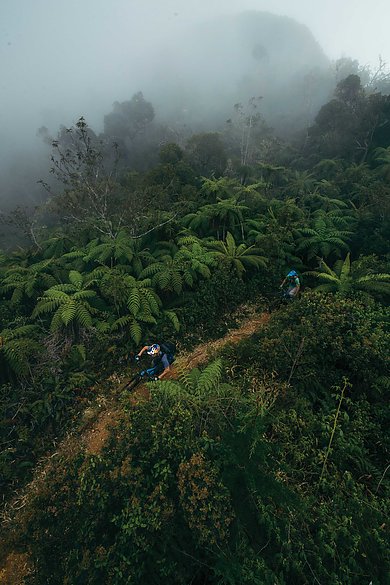
Our worries about the descent had been building since the parking lot, and for the first few minutes the fun, rowdy singletrack seemed to prove those doubts wrong. Then we hit the stairs. Sided with high walls and perilously steep, they were virtually unrideable, and we spent the next 6,000 feet either carrying our bikes and scrambling on foot, or white-knuckled and desperately trying not to flip over the bars. Things finally opened up a few hundred feet from the bottom into a short section of high-speed, multi-line singletrack that dumped out near a small farmhouse. The farmer offered us coffee, and we drank it gratefully while struggling to grip the mugs with our fatigued and battered hands.
It had been five hours since we first dropped off the summit, and the car ride back to Holguín would be about the same, with all of us packed into the back of a small sedan, so it was only sensible to break things up with some time at the beach. As we soaked our tired bodies in the turquoise water, I processed what we’d seen the previous few days. The amount of potential was almost frustrating—huge mountains, stunning forest and perfect dirt is almost always a recipe for great trails. Cap it off with white sand beaches, and you’ve got something truly exceptional.
But the ingredients are not enough on their own; someone has to do the actual building. That may seem like the obvious next step for North Americans, but get caught building rogue trails here and you’ll face stiffer consequences than the wrist-slaps we’re used to. Guilty until proven innocent, even for something as simple as moving dirt.

A mission like Pico Turquino deserves some rest and recovery, and we spent the next few days exploring the streets of Holguín and the surrounding area, even swapping bikes for mopeds for a beach mission. By the time the weekend rolled around, we were ready for our final day of trail searching.
Before the Turquino trip, Oscar had invited us to join he and a band of local mountain bikers on their weekly group ride. The crew was to meet the night before, at Michael Peña’s parents’ house. Peña is Oscar’s best friend and an avid biker, as evidenced by the stack of mountain bike mags taking over one corner of the home. As we waited for the group to arrive, we flipped through the issues. The newest was from 2008, and Peña pulled out one from the mid-2000s with a feature on Chase—he obviously needed a proper autograph. Chase signed the magazine with a sheepish grin, and had a momentary flashback to his younger days.
But knowledge can only do so much; as with Díaz, Peña’s biggest difficulty is acquiring parts. For the most part, if a local needs something specific they will get someone traveling to the United States—or a tourist traveling to Cuba—to pick it up.
Besides being a fervent rider, Peña is also a talented bike mechanic. Though there are a few shops in the city of 300,000, most provide only basic services and air for tires, and Peña is the sole tech in Holguín capable of fixing modern or higher-end mountain bikes. But knowledge can only do so much; as with Díaz, Peña’s biggest difficulty is acquiring parts. For the most part, if a local needs something specific they will get someone traveling to the United States—or a tourist traveling to Cuba—to pick it up. It’s a slow, unreliable process, and it can take more than a year to assemble all the components necessary to build a complete bike.

With parts being so hard to come by, recycling ability and ingenuity are a Cuban bike mechanic’s most valuable skills. Some issues are easier to fix than others—bearings can be repacked, tubes can be patched and chains can be fixed. The trickiest thing to replace, Peña says, are brake pads. They can’t be rebuilt and are useless once they wear out. His solution is to use auto brake pads. He carefully traces and cuts out the size he needs, epoxies it to the worn-out metal backing, and uses medical syringes to bleed the lines. It’s an arduous process, but one that works—a statement that also sums up mountain biking in Cuba in general. Like the Johnny Cash song about building a Cadillac, it happens one piece at a time.
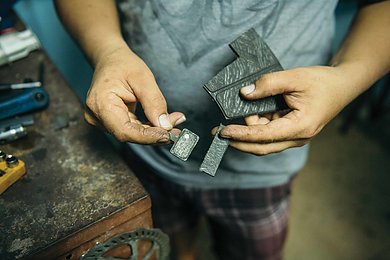
Nearly all of the 15 Cubans lined up for our race above Holguín are using Peña’s homemade brake pads, and the previous 30 miles of riding have proven their effectiveness. It’s a good thing, as the group is about to bomb en masse toward the narrow street below, the only visible opening in the town’s huddled buildings. If anyone’s brakes fail, they’ll most likely end up squished on a stucco wall.
The ride started on a dirt road early that morning. It had rained the night before and conditions were muddy, but it wasn’t much of an issue—despite this being our first proper “mountain bike” ride in Cuba, we found ourselves mostly connecting horse paths and jeep roads between tracts of farmland. Over the next 30 miles we plunged up and down, over fields and through streams and the occasional pile of horse dung. Almost halfway through the ride we stopped at a small farm, where we had coffee, homemade Cuban moonshine and some ribs one of the locals had been carrying (thankfully, giardia never set in). A bag of ribs and 20 miles to go—just another trail ride in Cuba.

It was early afternoon when we reached the site of the race start, after passing a farmer on a cart pulled by two oxen. Oscar explained the format: Everyone drops in at once and finishes at a swimming hole at the valley bottom, where more barbecue ribs would be waiting (and, rumor has it, more Cuban moonshine).
This, I realize, is mountain biking in Cuba. The country doesn’t have “trails,” at least not in the North American sense. The best options are dirt roads and 4x4 paths. But what it does have is a dedicated community so passionate they’ll do whatever it takes to keep riding. Two days from now, Chase, Dunfee and I will be back in the United States, surrounded by a wealth of modern trails and any piece of gear we want. It’s a realization that makes me grateful, and one that will motivate us to leave most of our gear behind, including knee pads, clothing, goggles and a proper bleed kit for Peña.
But right now, as the group lines up for a mass start, their random DIY assortment of bikes is even more obvious alongside Chase’s fancy carbon trail bike. And it’s wonderful. Like Joe Breeze and his jean-clad, Schwinn-mounted pals bombing down the fire roads of Marin County in the 1970s, all that matters for this motley crew is that it works. It’s hard to say what mountain biking’s future looks like in Cuba. But given any opportunity, folks like Oscar and Peña and Díaz will be there to build a bike culture as strong as anywhere, one piece at a time.

